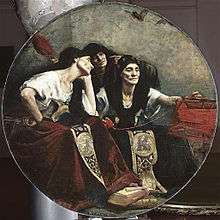Parcae

In ancient Roman religion and myth, the Parcae (singular, Parca) were the female personifications of destiny, often called the Fates in English. Their Greek equivalent were the Moirai.
Names and history
They controlled the metaphorical thread of life of every mortal and immortal from birth to death. Even the gods feared the Parcae. Jupiter also was subject to their power.
The names of the three Parcae were:
- Nona (Greek equivalent Clotho), who spun the thread of life from her distaff onto her spindle;[1]
- Decima (Greek Lachesis), who measured the thread of life with her rod;[2]
- Morta (Greek Atropos), who cut the thread of life and chose the manner of a person's death.[3][4][5]
The earliest extant documents referencing these deities are three small stelae (cippi) found near ancient Lavinium shortly after World War II.[6] They bear the inscription:
Neuna fata, Neuna dono, Parca Maurtia dono
The names of two of the three Roman Parcae are recorded (Neuna = Nona, Maurtia = Morta) and connected to the concept of fata.[7]

Nona was supposed to determine a person's lifespan on the dies lustricus, that is, the day on which the name of the child was chosen, which occurred on the ninth day from birth for a male and the eighth for a female.[8]
The recurrence of the nundinae was also considered a dies festus and as such nefas by some Roman scholars as Julius Caesar and Cornelius Labeo, because on it the flaminica dialis offered the sacrifice of a goat to Jupiter in the Regia.[9]
One of the sources for the Parcae is Metamorphoses by Ovid, II 654, V 532, VIII 452, XV 781.
Another source is Aeneid by Virgil, in the opening of Book I.
See also
- Fates
- Norns, equivalent of the Fates in Norse mythology
- List of Roman birth and childhood deities
References
- ↑ John Day, God's Conflict With the Dragon and the Sea: Echoes of a Canaanite Myth in the Old Testament, CUP Archive, 1985, p. 308.
- ↑ John Day, God's Conflict With the Dragon and the Sea: Echoes of a Canaanite Myth in the Old Testament, CUP Archive, 1985, p. 308.
- ↑ L. L. Tels de Jong Sur quelques divinites romaines de la naissance et de la prophetie 1959, pp. 70–77; 83–85.
- ↑ P. Ramat "Morta" in Archivio glottologico italiano 40, 1960, pp. 61–67.
- ↑ J. H. Waszinsk Gnomon 34, 1962, p. 445.
- ↑ G. Dumezil La religion romaine archaique Paris, 1974, part 4, chapt.
- ↑ L. L. Tels De Jong Sur quelques divinites romaines de la naissance et de la prophetie 1959 pp. 67–130.
- ↑ S. Breemer and J. H. Waszinsk Mnemosyne 3 Ser. 13, 1947, pp. 254–270: on personal destiny as linked to the collation of the dies lustricus.
- ↑ Macr. Sat. I 16, 30.
Further reading
- Thomas Blisniewski: Kinder der dunkelen Nacht. Die Ikonographie der Parzen vom späten Mittelalter bis zum späten XVIII. Jahrhundert. Thesis. Cologne 1992. Berlin 1992
External links
-
 Media related to Moirae at Wikimedia Commons
Media related to Moirae at Wikimedia Commons